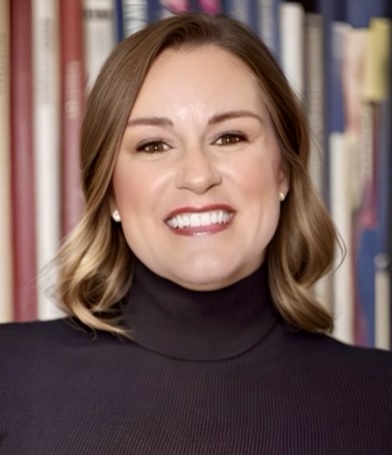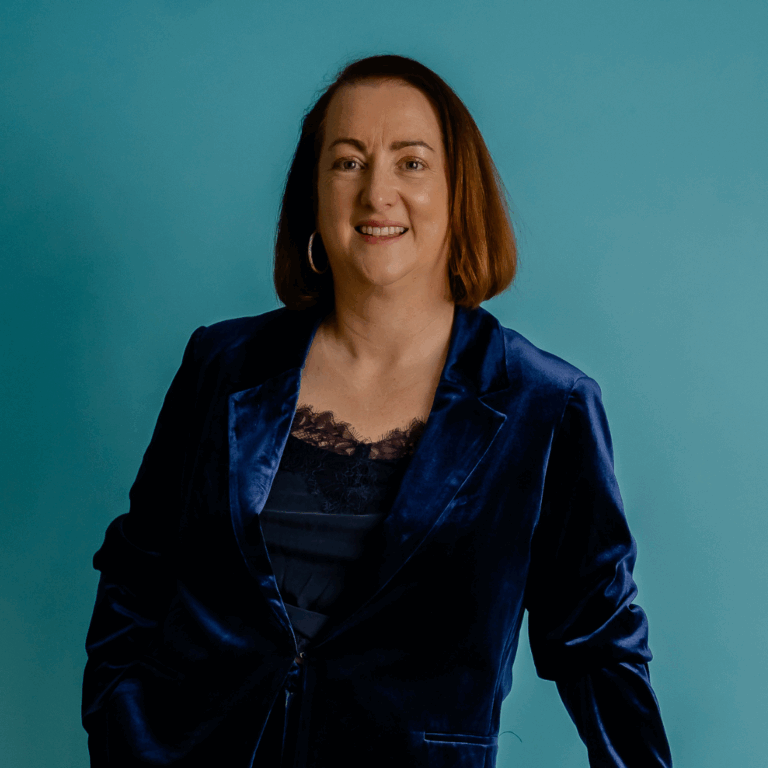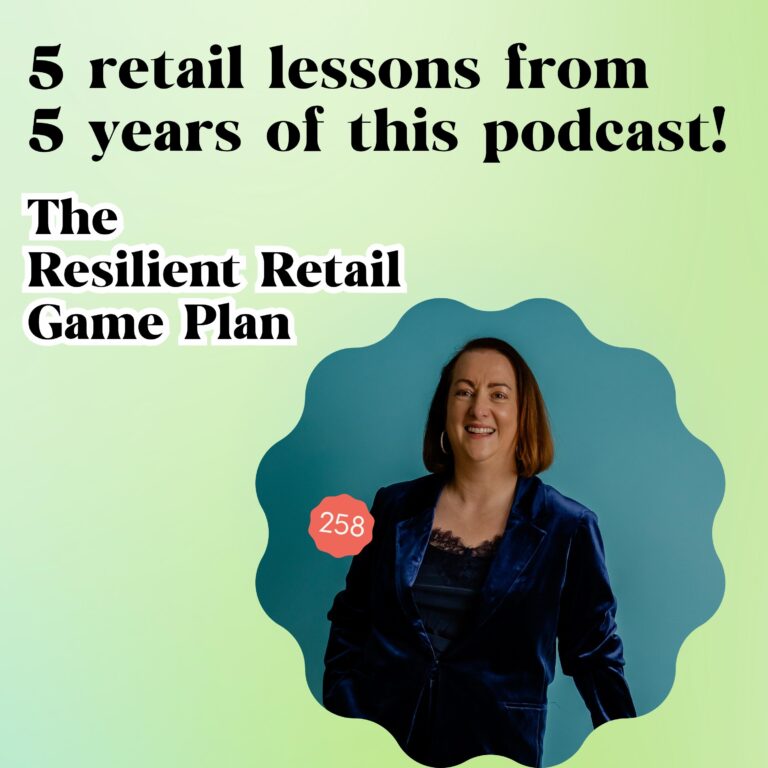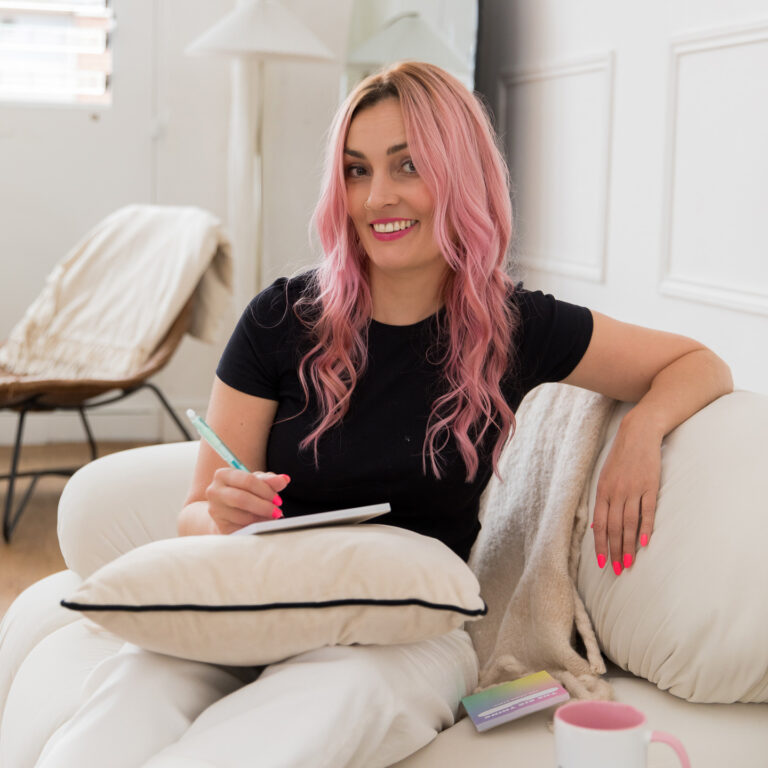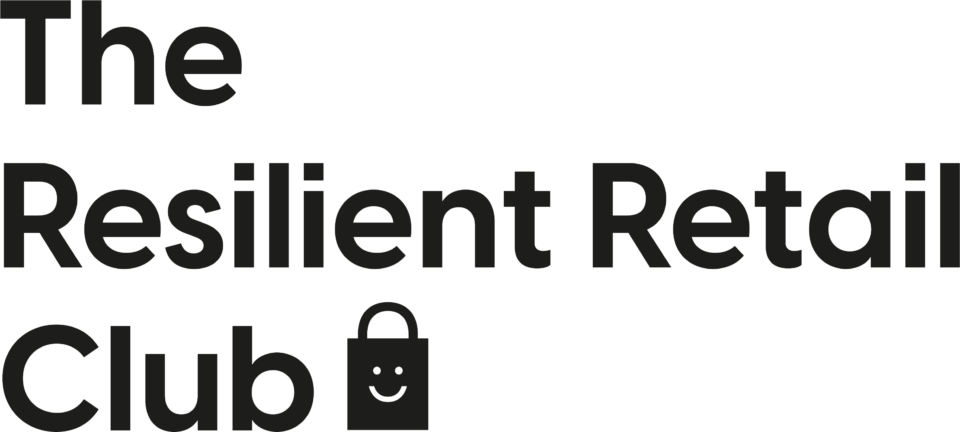Paid Advertising Secrets for Retailers with Aggie Meroni of White Bee Digital
Catherine Erdly: Welcome to the Resilient Retail Game Plan. Hi, I’m your host, Catherine Erdly. I’m a small business and retail expert. I’m also the founder of the Resilient Retail Club, which is my membership group and mastermind for product businesses. Go to resilientretailclub. com to find out more.
Today I’m joined by Aggie Meroni, who is a paid ad specialist and we’re going to be talking about all things paid advertising.
How it was in 2024 and what’s ahead for 2025. Don’t miss out on her super practical tips on how to boost the performance of your advertising.
Welcome to the Resilient Retail Game Plan, a podcast for anyone wanting to start, grow or scale a profitable creative product business with me, Catherine Erdly. The Resilient Retail Game Plan is a podcast dedicated to one thing, breaking down the concepts and tools that I’ve gathered from 20 years in the retail industry and showing you how you can use them in your business.
This is the real nuts and bolts of running a successful product business, broken down in an easy, accessible way. This is not a podcast about learning how to make your business look good. It’s the tools and techniques that will make you and your business feel good. Confidently plan, launch, and manage your products, and feel in control of your sales numbers and cash flow to help you build a resilient retail business.
Meet Aggie Meroni: Paid Ad Specialist and Founder of White Bee Digital
Catherine Erdly: Aggie, thank you so much for joining me on the podcast. Do you want to start us off by introducing yourself and your business?
Aggie Meroni: Hi Catherine, thanks so much for having me. My name is Aggie Meroni and I’m the founder of White Bee Digital. We’re a paid social agency, so we manage meta ads, Facebook and Instagram, Pinterest and TikTok for e commerce brands. And we help them to scale with the advertising.
Catherine Erdly: Fantastic. And let’s just jump in.
Black Friday Ad Insights
Catherine Erdly: How are meta ads working at the moment for retailers?
Aggie Meroni: It is because we’re recording this just after Black Friday. It’s going to have a Black Friday steer, like my answer, but it is such an interesting time of year compared to what we’ve seen in the past. So this year, Black Friday fell late. It was like right at the end, even went into December, which is really rare.
It’s usually about a week earlier. So we saw retailers start their Black Friday sales literally 1st of November. I honestly thought I’d been served the wrong ads. It’s like an ads manager somewhere, put them on a month early or something. I was like, this is really odd. But speaking to other retail retailers, they’re like, yes, because everyone’s comparing this year against last year, they have to hit November’s numbers at least.
So they start discounting earlier to make up for it. So, okay, that makes sense. But what we found at our agency is as a result of Black Friday being so late, Sales were slow, like through the whole of November and it was a nail biting month, I’m not going to lie, for our clients getting extremely tense saying, Oh my God, we’re down, we’re down, we’re down.
And ads follow human behavior and the sentiment. So if you see that something happens in the news and oh my God, interest rates are going up, your ads do suffer because people stop spending as much. So we noticed that with the ads. But the week off black friday, it started to kick off. Like people were starting to get those juicier deals coming in and Black Friday itself was the killer day.
Like we saw that as the day where the highest volume of sales happened. However, they weren’t the most profitable day for our clients. And the reason for that is their CPMs, which is the cost to show your ad a thousand times, went up nearly doubled sometimes. It was insane how expensive the ads become because all the big brands The household names, they flood the market with their ad spend.
So all the prices go up because everyone’s competing for those buyers on that weekend. So we found our clients who launched ads a couple of days before, some launched like the Monday of that week. They had very strong sales that whole week, and they were much more profitable before the actual Black Friday weekend happened.
But people did buy for the whole weekend. They dropped off a bit. On the Monday and there was a big dip the week after because everyone had bought all their deals and they’ve done their shopping and now it’s picking up again and I’m exactly this person. I’ve realized there’s loads of stuff.
I’ve got to buy. So now I’m buying it all. So we’re seeing that the results of that. Like coming back up again, and that is a pattern that you see every year. So it goes up a lot over the weekend. So you have a dip afterwards and then people start buying again and went back up in that zone. The ad costs have massively come down as well.
After that weekend, the fact like, you know, drops 30%, 50%, you know, they’re still high, but they’ve massively dropped. So I would say this is a time that a lot of retailers will make their profitable sales. Yeah.
2024 Advertising Landscape
Catherine Erdly: So that was black friday If you had to sum up and I know it’s hard to sum up a whole year But what what was your feeling of until black friday or what was your feeling in general about 2024 with ads?
Aggie Meroni: So again, it was very human behavior led. So this is something that the successful advertisers understand and the ones that struggle. It’s why they struggle. So
Advertisers, especially if they’re newer advertisers will put money into ads. And then if people don’t buy on day one, they’re like, the ads don’t work.
It’s okay, you need to remember that at the other end of your computer, there is someone who’s actually going to buy. They won’t buy necessarily the first time they see an ad. And I think because there’s been so much financial turmoil this year, the impulse buying has not been as great as it has been in the past, so people have found it harder to generate the sales that they used to get with ads.
However, the ones that peppered their sales with launches. So not just relying on evergreen sales, always the same, but , I want to be careful how I word this because it can be misinterpreted. So. When I say launches for one of our clients, they have a set product range and they don’t do much development, but how they merchandise those products was different.
So they re bundled something and renamed it and sold that as a launch. So I’m not saying you need to always innovate and always have like new stuff coming out cause that’s not profitable either, but how you, your messaging is so important. So the brands that, Adapted and looked around and what was going on and, changed up their messaging, changed up their creatives.
They did really well. So I’d say it’s not that there was a trend in ads that all ads were really good and all ads were really bad, but it was more like it was the business strategy behind the ads that drove results.
Catherine Erdly: Yeah. That’s so interesting. I totally agree with you specifically on newness, because I always say to people, you know, newness is just another opportunity to start a new conversation with your customer, but it totally could be, as you said, Putting two things together or a limited edition, something, or you buy in you, maybe if you develop your own products and you can’t be releasing new products all the time, you could have a limited edition packaging, or you could have one new color of one thing, you know, it’s.
It doesn’t have to be like a huge, in fact, it generally shouldn’t be like a huge product range all the time, but that will allow you to then have that conversation, which is, is a nice conversation starter, right? With a, with a customer. And it gives you something to build excitement around as opposed to repeating yourself.
And then the other thing that I was just going to say as well is that I definitely feel like the consideration window is getting longer and it sounds like you’ve seen the same thing. So people are needing longer to think about things, but presumably that is then part of the ads. Then it’s a shifting strategy, right?
So that you may have to show them more times or they may have to show different types of ads. Yes.
Aggie Meroni: Yes. And also how you interpret your data is different. So the biggest pitfall I see when I speak to advertisers is they panic because they’re like the ROAS is down and I’m not getting as many sales. I’m like, okay, let’s just take a breath. Where are you looking? What, where, where, where are you getting your information from?
And they’re like the ads dashboard. I’m like, okay. Do not just trust that because ads are only tracked for seven days after someone clicks the ad. So if you have something that’s maybe slightly more expensive, or maybe it would only be bought in a certain season, or, for example, like we’ve been selling workshops for one brand, they need to ask their friends. Are you available this day? Can Susan come on this day? Should we buy on this day? So it might take a couple of weeks for everyone to reply to that WhatsApp group to say we’re in. So then you won’t track that huge group sale from your ads because the people at the other end have taken longer to buy than Meta’s tracked.
So I always say Please, please, please, whether you are just looking at your Shopify dashboard or maybe you’ve got Suite analytics, triple whale, whatever it is you’re using, make sure you’re really tracking your revenue, not just day by day what sales are happening because it, you have to see like the general upward shift.
And also the data is changed as well since 2021 when we have this huge privacy updates, a lot of the data is delayed. A lot of the data is missing as well. So that’s why it’s really important to look at the bigger picture.
Catherine Erdly: Yeah. It’s interesting. I was, I saw somebody was talking on LinkedIn about this toothbrush called Suri, S U R I, which I actually bought one, I think
Aggie Meroni: I have one
Catherine Erdly: oh, you’ve got one.
Aggie Meroni: from an ad and actually one of my friends had it and recommended it. So no, you have to buy it. It’s really good though. Word of mouth as well. So it all plays into it.
Catherine Erdly: But it’s that whole thing about you know, it’s, it could be a really long journey. I mean, it was a pretty long journey. I don’t know how long I spent thinking about it, but I probably saw the ads and that alerted me to it. And then I did a bit of research on the website and then I maybe looked at the social or like you say, but then ultimately someone else says, Oh, I’ve got one and it was great.
And boom, that’s it. You know, so it’s, it’s so, it must, it’s an absolute nightmare, really attribution, isn’t it?
Aggie Meroni: Absolutely. And it’s what we call the messy middle. It’s really rare someone to see an ad and buy it straight away. especially, and I think that toothbrush is a really good example, and we work with a hair care brand and it’s the same thing. You’re disrupting a habit in someone’s life. So to change a toothbrush, you’re changing something that they use day to day that they’ve probably used for so long.
I mean, before that I had another electric toothbrush that I’d had not the same one, but the same brand for 15 years, I don’t know, a long time. So for me to then trust It’s not a cheap, cheap investment either. It was quite expensive for that product. So it was a considered purchase. He add that into it as well, but even haircare, even though the products price or unit price is much lower, someone has got trust in the existing brand and they’ve been using that for ages.
And there has to be something really disruptive to make them like stop the habit. And even if they stop buying your product, it’s not because they don’t like it. Maybe there’s something, maybe they got a big gift bundle, from a relative, or maybe they went abroad and bought something back. So, you know, there’s always other elements.
It’s not always just the ads that are causing the change in behavior.
Catherine Erdly: yeah, yeah, for sure.
Meta Platform Changes and Strategies
Catherine Erdly: So let’s talk a little bit about, you mentioned that things are changing. So obviously the meta platform changes all the time, but what are some of the latest changes and what do they mean for advertisers? Mm
Aggie Meroni: Sure. So there’s three areas that I’ve seen changes. So the first one is structurally inside the dashboard. It’s a big hoo ha for nothing. So they used to be business manager where you’d have like your umbrella of your assets, your ad account, Facebook page, Instagram account. Then they changed it to business portfolio. In September, which caused a tailspin because everyone panicked and was like, Oh my God, what is this? Even I did. I was like, I don’t understand why this has changed because it’s exactly the same thing. They’ve just moved everything. They’ve moved everything around and they called it something different, but all the elements that were in business manager are in business portfolio.
So if you see that, that’s what’s happened. They also decided to change the name of ads manager to adverts manager. Wow, you know, like these, these, these things are just ridiculous in my opinion. It doesn’t make any difference, but some of the bigger changes that will impact you. There’s like targeting differences now, so they’re not new, but it’s worth being aware of.
So Meta is doing a huge push to get people to use Advantage Plus audiences.
Catherine Erdly: Mm hmm.
Aggie Meroni: I would not recommend that right now. So effectively, and they’ll say you can switch back to the original audiences. I would recommend you do keep using original audiences. Now, the reason why I’m still pro original audiences is because advantage plus audiences are very algorithm led and AI driven.
So you can give a steer to Meta, just say, say for example, you’re selling hair care. So you’re like, okay, I want, people that are interested in hair care, personal care or, , whatever styling products, you know, you put all your interests in. Meta won’t just target people, those interests, it will just take it as a guide and still target everyone.
So you can’t really, you don’t really know If you’re targeting has had any impact,
Catherine Erdly: Right.
Aggie Meroni: you also can’t exclude any audiences with advantage plus. Now this is really important if you’re trying to just target fresh people. So if you just want new eyes on your ads, you want to be able to exclude your website visitors, your social media, engages your email list, your past purchases.
You can’t do that with Advantage Plus. So effectively, Meta is going to go for the low hanging fruit all the time. It’s going to go for all the warm audiences. So you’re just going to waste your money because you’re just going to be re showing to the same people and to grow. You need new people. You need new eyes. So if you’re in growth mode, Go for original audiences.
One thing that is a really good feature is audience controls, they’ve now got two sections where you can actually tell Meta who the engaged people are in your audience and who your past purchases are.
So when you do run a report, you can see how much of your budget is actually going to completely fresh. eyes, which is really, really important because again, you want to make sure that you’re not just showing the same people all the time what you’re selling. So I would say search for that in your settings.
It’s an ad set settings, and you can set that for yourself. And thirdly, creatives. So creatives are like the big thing now, now that audience targeting isn’t as precise. Meta, again, is trying to force you with AI to let them tweak things for you.
Disaster. Don’t do it. It just looks horrendous. So you’ll have an option when you’re uploading your imagery, videos, everything. It pops up this big dashboard of enhancements and it will just auto selects most of them, I would just deselect everything, have control over how ads look.
Catherine Erdly: So, what kind of , what kind of enhancements? What are you seeing it trying to do?
Aggie Meroni: It will try and put a new background on your product image. It will do random text overlay. It will jumble up all your ad copy across different areas of your ad. If you’re quite sensitive from a brand visuals perspective. It looks very ugly because it brings in odd colors, odd fonts as text overlay.
It looks awful. And it will auto apply things as well. So I’ve had instances where ads have been live and they’ve just sort of released some new enhancements and just auto applied it to all my ads that are live. And then I’ll be served an ad and I’ll be like, what is this? I did not set this. So I have to go through every single account to switch off all these enhancements.
So just be aware that that’s happening. They also have AI generated ad copy,
Catherine Erdly: Right? Mm-hmm
Aggie Meroni: So it’s getting better, I have to say. So there might be certain phrases or different ways of saying the same thing that you might actually like. If that happens, go for it, you know, add it to your campaign.
We haven’t really been using it because it isn’t really, I don’t think, good enough yet. But there are certain phrases that have come up. I’m like, it’s getting better. That’s actually quite a nice way to phrase something. And there’s one other sneaky setting that I would just flag. Which is multi advertiser ads.
They’ll be like a little box that they’ll auto select for you. Deselect. Because what they’ll do is they will show your ads next to your competitor ads. Now, we don’t want this. They’re like, where, where your performance may improve. It’s we don’t want to be associated with our competitors. And also all it takes is like a slip of the finger and you’ve gone to your competitor’s website and they’re suddenly buying from, you know, your competitor or whatever.
So no, we are not, we are deselecting. So those are the key changes in those areas.
Catherine Erdly: so why do they think they’ve done that?
Aggie Meroni: So I think it’s because the meta algorithm is the most sophisticated one in the world, and that’s why it’s so powerful. And when you’re running, say, an advantage plus shopping campaign, we have found that the longer those run, the more efficient they become because the algorithm learns.
Catherine Erdly: Mm,
Aggie Meroni: So I think they’re trying to use the same thinking that if we give loads and loads of data to our algorithm, then it will automatically create these amazing ads. The thing is, if you let it, it’s effectively using your ad budget and your business as a testing ground for their own benefit. So it’s not, it just isn’t good when you do it. So that’s what my thinking is on that. They’re training their own algorithm with your content.
Catherine Erdly: right, right. I see. Which is not, not, yeah, not what, know what you want.
Boosting Ad Performance: Practical Tips for Retailers
Catherine Erdly: So if a retailer is looking to boost their performance, but they don’t want to go down the route of allowing meta free reign. What are some , what are some of the simplest things that they could do to, to boost the results?
Aggie Meroni: So number one. You need to be very strategic as a business owner. So first of all, audit your products, what is actually selling organically? What are your best sellers? What sells well together? And those are the things you should be focusing on, because if there is organic demand for those things, if you put money behind it, fresh people will also want that thing.
So that is the, honestly, the quickest way to improve your ad results by showing the right things.
Also be bold. So what I mean by that is be really observant on your own phone about ads that stand out to you. So you will notice the simplest ads perform the best. So I see so many times that advertisers get a bit overwhelmed.
They’re not really sure what to show in the ads. So they put lots of things. There’s lots of like product cutouts of one image or there’s lots of text overlay and for someone that’s fresh to your business, they’ll just look at that and go, Whoa,
Catherine Erdly: Yeah.
Aggie Meroni: I don’t know what I’m supposed to look at here. This is, there’s a lot of information and you just have to remember how people consume social media.
So they’re literally swiping, talking to friends, watching TV, cooking. They’re not really focusing that much. So you need like bright colors. Bold text, something that’s just going to grab their attention or, a video that really short punchy video with a read like this. We call it front loaded.
So the fact that the most important thing in that video is right at the beginning so that they’re hooked in and want to watch the rest. That will do really well for you. So if you’re used to making reels. Do that. Even GIFs. So if you’ve just got static images, you can add them to Canva to a GIF and it’ll just keep replaying these like flashing images.
That can be quite effective. That’s quite easy to do. And I’d say we touched on it earlier and it’s not something I can say lever or this lever. Just remember who you’re speaking to in your ads and how they buy from you. So smaller businesses are actually, they have an advantage on this because I think they know their audience better, the bigger brands, because they’re in the DMS with them all the time.
Maybe they’re seeing them in actual like fairs. They’re talking to them every day. So they know what their motivations are. They know the emotions behind why they’re buying. They might get ideas on complimentary things that they can sell them as well, like cross sell upsell. That’s where you’ll make the money.
So getting them to spend more and again and again and again, that’s where you get the most return for your ads. So I think a lot of advertisers look for the dopamine hit of the ads, make the sale today and you need that to have the cash flow in your business. But there are also these other sort of satellite things that you need to be thinking about, which do actually improve your results the most.
Catherine Erdly: So those would be things like brand building and explainer videos or
Aggie Meroni: absolutely. Like even like a gift unboxing video because you’re buying people into that emotion of Oh, what a nice, beautiful, like someone like that. Sandra would love that as a gift or I’m going to give that to myself because I deserve it. I’ve had a really hard time recently and you see that angle in a lot of ads like self gifting is quite a big message that you see online but also, you know, I was talking to a brand earlier about matchy matchy things, you know, it’s a big trend to have the whole family in the same pajamas or to have matching wellies or to have, you know, football kits that dad and son or mom and daughter or whatever.
So it’s that emotional connection. It’s like the bonds that you’re cementing or activities you can do together, but you kind of hint at them. In the ads, that’s what gets people buying.
Catherine Erdly: Right. Yes. And what do you think about the role of like user generated content? Or do you think it’s better to create your own specific content?
Aggie Meroni: So this is actually a bit of a talking point in the ad world at the moment.
Catherine Erdly: Okay.
Aggie Meroni: So I’m glad you asked. So user generated content as an ads manager, if it’s done well, it’s gold dust, but it’s amazing. And what you consider as good content is obviously you don’t know until it’s tested in the ad account.
But I know from working with my clients, it’s so hard to get decent imagery from customers. Like even if they have good intentions and they take the time to take photos for you, maybe it’s out of focus, maybe the background is really bad, maybe like you know if it’s jewellery there’s a stray hair in it which you can kind of photoshop out but then it looks a bit weird or you know the lighting’s really bad and it’s really frustrating.
You know it’s on goodwill, you can’t really say oh do you mind just reshooting that for me because the moment’s gone for them, you know they wore that outfit and that earring or whatever. The thing that is, Absolutely killing it at the moment is employee generated content. So this is your team, your staff, even you, if you’re a founder doing like QVS style videos. When you see live selling on TikTok, TikTok shop and people are making like six, seven figures from these like live demos, if you can replicate mini versions of those for your ads.
Test those. they have been doing really well for us. Obviously, it’s a genre, so not every single ad that you create. That’s like that will do well, but we’re seeing more of those types of ads doing well because it’s the, it’s the human element that people want to see behind the scenes. They want to see your passion for your products.
Like, why should I care? And like founders and small teams care.
Catherine Erdly: Yeah.
Aggie Meroni: cut that really comes across in the ads.
Catherine Erdly: yeah, for
Aggie Meroni: So yeah, I would, and it’s cheap to do right. You just need a phone and someone that’s willing to do it. He’s pulling the straw. You know, he’s pulling the short straw today.
Like you are in the video today. I
Catherine Erdly: Amazing. Thank you so much. This has been really in really useful and and thanks for giving the overview.
Looking Ahead to 2025
Catherine Erdly: So into 2025 then what’s your, what are your thoughts about advertising in 2025?
Aggie Meroni: I think it’s really important to have a long term view. So I would. Be strategic in your marketing budget. So you have enough to advertise through your quieter periods and your more busy periods. As I said, having a human touch to your marketing is, seems to be what’s working at the moment. And also making sure you invest enough time in thinking about your content. So it’s very intentional. So you, you know, you’re really, really talking to who you want to in your ads. That is, that is what will make them sell.
Catherine Erdly: Brilliant. And if people wanna find out more about you and White Bee Digital, where should they go?
Aggie Meroni: Sure. So you could I’m either on Instagram at white B digital, or you can find me on LinkedIn at Aggie Meroni.
Catherine Erdly: Thank you so much for tuning in. Please do take a moment to rate and review the podcast if you could in Spotify or Apple podcasts. And if you of course follow or subscribe, whatever it’s called on the platform you’re on, you’ll be the first to know about every new episode that comes out every Thursday morning. See you next week!

